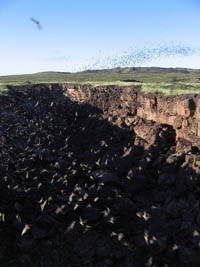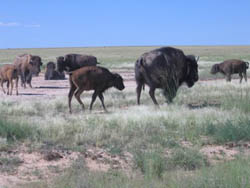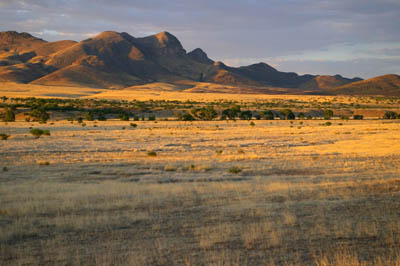|
 |

| Preliminary Detailed Schedule and Readings |
To give you a deeper sense of our Nature and History at the Nation's Edge summer institute, we have posted our preliminary daily schedule, including institute readings and recommended resources, below. This preliminary schedule is subject to change. You will soon be able to download the complete preliminary detailed schedule and readings as a .pdf file.
WEEK ONE
WEEK TWO Field Study
Sunday, 21 June
We will gather at 11:30 for a noon departure for the field study tour. We’ll travel from Tucson in UA Motor Pool vans to the Armendaris Ranch just outside of Truth or Consequences, New Mexico, and settle into the modern ranch bunkhouses for a 4-night stay. We’ll meet the Armendaris Ranch manager, Tom Waddell, and Diana Hadley (Office of Ethnohistory, UA), who will join us for a dinner and introduce the ranching enterprises in the borderlands, and the historical and ecological restoration work being done on the Armendaris Ranch (located on a former Mexican land grant along the old Camino Real into Mexico). Diana Hadley is currently completing an ethnoecological history of the ranches.
Recommended: John Stilgoe, Outside Lies Magic: Regaining History and Awareness in Everyday Places (New York: Walker and Co., 1998).
Monday, 22 June
Today we’ll begin to immerse ourselves in the semi-arid savanna landscape that dominates the Armendaris Ranch, with a focus on several specific animals and the human and environmental histories within which they have been embedded. In the morning, with wildlife biologist and environmental historian Dr. Joe Truett as our guide, we will visit restoration sites for Aplomado Falcons and Bolson Tortoises, and discuss how the histories of these two species during the last century has been tied to human transformations of nature and efforts of science to comprehend and counter these changes. The story of the Bolson Tortoise is particularly apropos to our field institute, since this population is historically indigenous to Mexico, and its restoration north of the border speaks volumes to the transnational dimensions of ecological science. After lunch, Joe Truett and principal faculty Dr. Marsha Weisiger will lead a discussion of grazing, management, and restoration within a context of changing human values and paradigms. Participants will have the option to have time on their own or to join a drive around the ranch to study the effects of grazing (and what has happened since ranch managers have removed the animals from the range), and to look at the ranch’s herd of Oryx, an exotic species from Africa whose introduction into New Mexico had a range of unintended consequences (considered now by many to be a pest). The day ends  with a rare treat: dinner near a series of lava tubes that are home to several million bats, and the second-largest bat flight in the United States. This bat population moves between the U.S. and Mexico, and we’ll discuss how scientists are comparing data from this site with data from Mexico to generate a transnational measure of environmental heath. These bat caves were also the site of a guano mining operation at the turn of the century, and we’ll have a chance to examine the old buildings, roads, and technological remains (looking forward also to our later visit to the industrial landscapes of the “copper borderlands”), and talk about the juxtaposition of extractive and scientific landscapes. with a rare treat: dinner near a series of lava tubes that are home to several million bats, and the second-largest bat flight in the United States. This bat population moves between the U.S. and Mexico, and we’ll discuss how scientists are comparing data from this site with data from Mexico to generate a transnational measure of environmental heath. These bat caves were also the site of a guano mining operation at the turn of the century, and we’ll have a chance to examine the old buildings, roads, and technological remains (looking forward also to our later visit to the industrial landscapes of the “copper borderlands”), and talk about the juxtaposition of extractive and scientific landscapes.
Readings: Josh Donlan, et al., “Rewilding North America,” Nature (2005), 913-14; Joe Truett, “Aplomado Falcons and Grazing: Invoking History to Plan Restoration,” Southwestern Naturalist (2002): 379-400; Marsha Weisiger, “Hoofed Locusts,” in Dreaming of Sheep in Navajo Country (Seattle: University of Washington Press, [2009]).
Recommended: Joe Truett, essay on the Bolson Tortoise, Conservation Biology (forthcoming 2008); Robert H. Webb, et al., The Ribbon of Green: Change in Riparian Vegetation in the Southwestern United States (2007).
Tuesday, 23 June
After breakfast, we’ll head to the Ladder Ranch, adjacent to the Armendaris, to focus in depth on one of the most publicly contested restoration projects: the reintroduction of the Black-Tailed Prairie Dog. Eradicated in the 1920s and 1930s by ranchers and government officials, this former animal pest was brought back to the Ladder and Armendaris ranches in the 1990s to the consternation of many local ranchers. Before lunch we’ll visit two different prairie dog colonies with Joe Truett, who was responsible for the initial reintroduction during the 1990s (also an expert on the history of the prairie dog, its eradication in the early twentieth century, and the ecological consequences of its reintroduction). Our discussion will focus on a series of environmental history riddles: how have we distinguished historically between “bad” and “good” animals, what were the consequences of these human decisions, and how are land managers and ranchers rethinking the moral ecology of the borderlands? After lunch at the Ladder Ranch headquarters, Joe Truett and ranching historian Dr. J.C. Mutchler will discuss the debated terrain of restoration and ranching in the borderlands with the group. In the afternoon, participants can choose to relax back at the Armendaris, or drive with Mutchler and Truett to several nearby sites to look at examples of vegetation and wildlife restoration projects.
Readings: Susan Jones, “Becoming a Pest: Prairie Dog Ecology and the Human Economy in the Euroamerican West,” Environmental History 4 (October 1999): 531-552; C. Hart Merriam, “The Prairie Dog of the Great Plains,” Yearbook of the USDA (1901): 257-70;
Recommended: Jerry L. Holecheck, “Western Ranching at the Crossroads,” Rangelands 23 (2001), 17-21; Conrad Bahre, “Human Impacts on the Grasslands of Southeastern Arizona,” in The Desert Grassland, pp. 230-65.

|
|
 |
 |
Wednesday, 24 June
On our last day on the New Mexico ranches, we will explore some of the more deeply-engrained human and animal histories that connect the Armendaris Ranch to both the U.S. Southwest and Mexico. In the morning, we will drive to the ancient roadbed of the Camino Real, the highway that connected this region to Mexico City during much of the colonial period, and served as one of the central corridors for U.S.-Mexico trade after the 1820s. We will pause at Tucson Springs, an old stopping-point on the trail, and compare what we see on the land today with what we’re able to tell from nineteenth-century travelers’ accounts (included in our readings). Among local species whose populations were transformed by travelers and immigrants were bighorn sheep and mountain lions, whose populations shifted in surprising ways with the introduction of new domesticated animals (cattle and sheep) in the borderlands. We will drive from Tucson Springs into the Fra Crístobal range, where game biologists have reintroduced endangered bighorn sheep and are now studying their relationship to mountain lion populations. Our guide will be Harley Shaw, a mountain lion specialist who is working on a history of the local U.S. Bureau of Biological Survey pioneer J. Stokely Ligon. After lunch Shaw, Marsha Weisiger, and Joe Truett will discuss the historical relationships among mountain lions, wolves, and bighorn sheep and their relationship in turn to border ranching. In the afternoon, participants will have the option to visit one of the many Turner bison herds, one of the most symbolically indigenous animal populations in the U.S. West. Tom Waddell and Joe Truett will discuss the bison both as a historical icon and an economic cornerstone of the Turner ranching enterprise. We will conclude our final day with a farewell feast of bison burgers and relaxation at the Armendaris Ranch bunkhouse, where the participants will have the chance to mingle informally with the various speakers of the previous three days.
Readings: Marsha Weisiger, “The Debate over El Lobo: Can Historians Make a Difference?” Public Historian; Thomas R. Dunlap, “American Wildlife Policy and Environmental Ideology: Poisoning Coyotes, 1939-1972,” Pacific Historical Review 55 (August 1986): 345-369; 19th-century travelers’ accounts packet (Susan Magoffin, Philip St. George Cooke, John Russell Bartlett).
Recommended: Joe Truett, “Bison and Elk in the American Southwest: In Search of the Pristine,” Environmental Management 20 (1996), 195-206; Dan Flores, “Bison Ecology and Bison Diplomacy Redux: Another Look at the Southern Plains from 1800 to 1850,” in The Natural West.
Thursday, 25 June
In the morning we’ll travel to the American Museum of Natural History, Southwest Research Station, and settle into our housing accommodations for a 4-night stay. The afternoon seminar with visiting scholar Dale Curtis Miles, former San Carlos Apache Tribe historian, and principal faculty Dr. Paul Hirt (History, ASU) will examine Apache tenure in the 19th century. We’ll draw on the now classic work by anthropologist Keith Basso with Western Apache of the greater Cibecu region to guide our discussion of Apache cultural and ecological landscapes. Dale Miles will join us for dinner at the Southwest Research Center to continue our discussions in a more informal setting. As an optional evening event, we will screen the documentary film, Geronimo and the Apache Resistance by Neil Goodwin, which relies on oral histories with Chiricahua Apaches to offer their cultural story of Anglo-Apache interactions.
Readings: Keith H. Basso, “Preface” and “Wisdom Sits in Places,” in Wisdom Sits in Places: Landscape and Language among the Western Apache, pp. xiii-xviii, 105-49; Paul Hirt, “The Transformation of a Landscape: Culture and Ecology in Southeastern Arizona,” Environmental Review 13 (Autumn 1989): 167-89.
Recommended: Grenville Goodwin and Neil Goodwin, The Apache Diaries: A Father-Son Journey; Edward F. Castetter and Morris E. Opler, Ethnobiology of the Chiricahua and Mescalero Apache (1936)
Friday, 26 June
Through a field study tour, led by Dr. Paul Hirt and Diana Hadley, we’ll examine contact and conflict in the mid-late 19th century. We’ll visit Pinery Canyon (the site of the federal Chiricahua Indian Agency before the extensive Chiricahua Reservation was abolished in 1876) and Faraway Ranch (a historic homestead of the Erickson/Riggs family, which still owns working ranches in the area). Kate Nielson (NPS) and Dale Miles will join us as experts at the Chiricahua National Monument. Since these sites are located in the mountains (at elevations from 4500 to 8000 feet) we will benefit from cooler temperatures. In these three locales, we’ll compare and contrast the environmental perspectives of the area’s 19th-century homesteaders, soldiers and natives through an analysis of their writings and activities. Our discussion will focus especially on how landscape ecology and cultural differences shaped historical events. We will return to the Southwest Research Station by 3pm to provide time for reading and reflection.
Readings: Lysa Wegman-French, "Federal Presence in the West," Faraway Ranch Special History Study, 32-65; Katherine Benton-Cohen, “Common Purposes, Worlds Apart: Mexican-American, Mormon and Midwestern Women Homesteaders in Cochise County, Arizona.”
Recommended: Frederick R. Gehlbach, “Mountain Islands” and “Canyon Trails,” Mountain Islands and Desert Seas; Alden Hayes, A Portal to Paradise; Edwin R. Sweeney, Mangas Coloradas: Chief of the Chiricahua Apaches; John Bourke, An Apache Campaign in the Sierra Madre; Jason Betzinez and Wilbur S. Nye, I Fought with Geronimo.
Saturday, 27 June
This day will explore early 20th-century developments in land management, through a morning study tour of the historic Rustler Park Fire Guard Station and the U.S. Forest Service’s Barfoot Peak Fire Lookout. We will be joined by environmental historian Dr. Stephen Pyne (ASU), one of the foremost experts on the cultural history of fire, who will conduct a field seminar on borders and fire history in the borderlands. Through discussion of the assigned excerpts by Pyne, Turner and Dobyns, we will explore the scholarly controversy over the history of fire—whether of human or natural ignition—in shaping the mosaic of borderland environments. The provocative essay by Jake Kosek uses the history of Smokey the Bear’s contested meanings in the Southwest to raise questions about the coupling of nature with an imagined national community. In the afternoon seminar, held indoors at the Southwest Research Station, we will turn to the late 20th century and consider contemporary trends in land management and conservation. Paul Hirt will use the Chiricahua case study to open up a discussion of the changing relationships among NGOs, landowners and government agencies.
Readings: Stephen Pyne, Smokechasing, pp. 141-177, and 212-218; Raymond M. Turner, The Changing Mile, pp. 26-35; Henry Dobyns, From Fire to Flood, pp. 27-37; Jake Kosek, “’Smoky Bear is a Racist Pig’,” Understories, pp. 183-227.
Recommended: Kimrod Murphy, Lost Trails of the Arizona Game Rangers; Stephen Pyne, “Burning Borders,” Environmental History 12 (October 2007): 959-65; Donald J. Pisani, “Roots of Forestry, Forests and Conservation, 1865-1890”; Stephen Pyne, Fire in America, pp. 514-29.
Sunday, 28 June
On our final day at the Southwest Research Center, participants will have a break from seminars. They will have time to do laundry, organize, read and write. We will offer planned optional events and activities: birding walks, nature hikes, and presentations by residential experts.
Recommended: Jeanne Williams, Harvest of Fury; Weldon F. Heald, The Chiricahua Mountains.
WEEK THREE
WEEK FOUR
|
|
|
|

 with a rare treat: dinner near a series of lava tubes that are home to several million bats, and the second-largest bat flight in the United States. This bat population moves between the U.S. and Mexico, and we’ll discuss how scientists are comparing data from this site with data from Mexico to generate a transnational measure of environmental heath. These bat caves were also the site of a guano mining operation at the turn of the century, and we’ll have a chance to examine the old buildings, roads, and technological remains (looking forward also to our later visit to the industrial landscapes of the “copper borderlands”), and talk about the juxtaposition of extractive and scientific landscapes.
with a rare treat: dinner near a series of lava tubes that are home to several million bats, and the second-largest bat flight in the United States. This bat population moves between the U.S. and Mexico, and we’ll discuss how scientists are comparing data from this site with data from Mexico to generate a transnational measure of environmental heath. These bat caves were also the site of a guano mining operation at the turn of the century, and we’ll have a chance to examine the old buildings, roads, and technological remains (looking forward also to our later visit to the industrial landscapes of the “copper borderlands”), and talk about the juxtaposition of extractive and scientific landscapes.